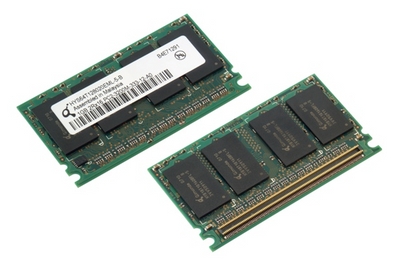Programs and data stored in secondary storage must first be loaded into main memory before the processor can use them. Memory directly accessible to the processor includes main memory (RAM), cache, and the CPU registers.
| The RAM is where the programs are kept when they are running; it also contains the data needed by the running programs. In contrast to sequential access memories, such as magnetic tapes, RAM means that memory accesses take basically the same amount of time no matter what portion of the memory is read. |
The RAM below is found on a small board and each board contains eight integrated circuits. It is built from DRAM (dynamic random access memory) chips. It is “dynamic” because in order for the memory chip to retain data, it must be refreshed constantly (every few milliseconds). Several DRAMs are used together to contain the instructions and data of a program.
| The DRAM chips are mounted on these boards (called DIMMs) and then plugged into the connectors. The DIMM (dual inline memory module) is a small board that contains DRAM chips on both sides. On the other hand, SIMMs (single inline memory modules) have DRAMs on only one side. |

|
|
“Nowadays most people die of a sort of creeping common sense, and discover when it is too late that the only things one never regrets are one’s mistakes.” ― Oscar Wilde, The Picture of Dorian Gray |